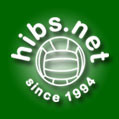Although large numbers of Glasgow Irishmen still wanted to follow the fortunes of Hibernians, poor form and bad results when the Edinburgh men visited that city caused many of them to turn their eye toward a successful Irish team – Celtic.
In a poor start to 1889 a 5-2 loss to Hearts did little to raise the spirits and even some of the loyal Edinburgh Irishmen did not just blindly turn up to cheer the greens but chose their matches and appeared less often on the terraces. One such game they did turn up for was at Tynecastle where a creditable 1-1 draw was achieved and so Hibernians was still in business when the first ever Scottish League was formed but for some bizarre reason lost in the mists of time Secretary Richard Payne did not attend the meeting and so the greens were not invited to join.
It was certainly true that the Irish of Glasgow had turned their attentions towards the fortunes of Celtic but there was still a large Irish contingent in Lanarkshire and they had mainly stayed loyal to Hibernians, turning out in large numbers to watch they play and win games in Airdrie whilst still further support was evident in witnessing a win at Falkirk. Out of the Scottish Cup and the East of Scotland Shield Hibernians had to resort to a series of friendly games until they were drawn to play Hearts at Logie Green in the first round of the Rosebery Charity Cup. In front of an enormous crowd exceeding 10,000 the greens went down 3-2 in a match many felt they should have won but at least the charity benefited with a very healthy £242 being raised.
After losing almost an entire team to Celtic the Hibernians were but a shadow of their former selves on the playing field but the men who ran the club were determined to make the best of what they had. Some of those men had, would or would continue to be the ones to whom future supporters of the Hibernians would owe a huge debt of gratitude including Life President Canon Edward Joseph Hannan, President Michael Whelahan, Treasurer Thomas Nolan and from the playing side the highly respected and fiercely loyal James McGhee. When others around him had been easily lured away with promises of riches, James McGhee refused to leave Hibernians and was the mainstay around which the newly forming playing side was created. Such was his loyalty that the club decided, upon learning of his intention to marry, to award him a Testimonial and invited anyone wishing to join in with the giving of this gift to contact Secretary Richard Payne. It was no more than McGhee deserved as he was probably the first ever Hibernian player to truly deserve the title of club legend.
In June 1890 the Scottish Football League was formally constituted but due to Secretary Richard Payne’s reticence Hibernians were not part of the original set up and would only to be able to watch from the outside as League football got under way. It would be friendlies and local Cup competitions again for the Hibernians but in all truth the unattractive fixture list was the least of its troubles as dark days lay ahead.
In a period of the club’s history where bad news seemed to follow bad news there was a ray of hope when it was learned that like James McGhee before him, Sandy McMahon had resisted offers from other clubs and had vowed to stay with Hibernians to help the club in its quest to regain its former glory. The commitment of McGhee and McMahon should not be underestimated as money was tight and the financial rewards on offer were attractive but these were men of their word – true Hibernians.
Since Celtic had been founded the areas surrounding Glasgow had been considered by them to be their own in terms of seeking out and signing promising new players but Hibernians gave that idea not a single thought and set about inviting a number of the most promising players from Ayrshire and Lanarkshire to Easter Road for trials. On 6 August 1890, Hibernians’ 15th birthday, a challenge match took place at Meggatland as part of the Edinburgh International Exhibition and the competitors were Hearts and Hibernians. A crowd of 20,000 turned up to watch, Edinburgh’s biggest up to that date and Hearts won 2-0 with a goal in each half. Significantly for the Hibernians was that the game marked the debut of James Blessington. Not being part of the new League set up greatly angered the fans of Hibernians as they wanted to see their favourites playing against the best teams in Scotland but of course those in the League were too busy playing each other although Richard Payne did manage to arrange a game against one of the founding members, Abercorn.
The other nine clubs in the founding League were Celtic, Rangers, Cowlairs, Vale of Leven, St. Mirren, Hearts, Dumbarton, Third Lanark and Cambuslang. On the field of play the Hibernians were not having the best of times at all and lost games far more regularly than they had ever done before. Things came to a head on 27 September 1890 when they lost 9-1 to Dumbarton at Easter Road in the second round of the Scottish Cup. As if that result was not bad enough but after the game the Hibernians found out that they would never play on that Easter Road park again as the owners had not been asked to renew the lease and now had different plans for the land. There seems little doubt that the villain of the piece was Richard Payne who had not negotiated a new lease and as a result the Hibernians did not have a home ground and had to satisfy themselves with playing away matches which was to cause great unhappiness amongst their support.
At this point, without a home the Hibernians basically ceased to function and the possibility of the club going to the wall was a serious possibility. Frantic attempts to secure Logie Green or Powderhall were unsuccessful and just when the club was at its lowest ebb the vultures of Celtic Park once again loomed on the horizon. Having left Hibernians to join Celtic, Willie Groves had moved again when he joined West Bromwich Albion and Celtic needed a replacement so they approached both Sandy McMahon and James McGhee. The two players told the Committee of Hibernians of the approach and made it clear they would not leave if the club was to find a home and begin playing again but such assurances could not be given and so it was with a heavy heart that Sandy McMahon and James McGhee left the club to join Celtic. Their loyalty to Hibernians was true to the end but they had families to support and the Hibernians Committee gave its blessing to the move.
The stress of the situation was at the root of unrest amongst the Hibernians Committee members with many arguments taking place regarding how and if the club should continue. Canon Hannan’s good friend Father O’Carroll, Chaplain to St. Mary Star of the Sea CYMS became aware of the unrest and approached Charles Perry who was Secretary of the Hibernians second Xl asking him to use the Society’s resources to help the Hibernians in their hour of need. A staunch fan of the Club, Perry spoke to some of his friends in the Stella Maris Church in Leith and plans began to be formulated to rescue the club.
With Michael Whelahan’s blessing, Perry negotiated with Leith Athletic to allow Hibernians to share their park at Hawkhill as well as putting forward the idea that for a spell, until the club was back on its feet, it should play as Leith Hibernians. The latter point came about because the SFA had declared dissatisfaction with the accounts of Hibernians and by naming the ‘new’ club Leith Hibernians it allowed that matches could be arranged and played while the business with the SFA was sorted out. The men from Stella Maris who supported Perry all the way were delighted when he was appointed Match Secretary of the club as was Richard Payne who was elected as President. Amongst those who supported Perry were Patrick Smith, James Dickson, George Chambers and two brothers named John and Phillip Farmer.
The first task for the new Committee was to secure the services of players and to do so they turned to their various nursery teams that had continued playing throughout. Already James Blessington had been picked up from Harp Athletic and he would be the first of many to play for ‘Leith’ Hibernians who were back in business. The first competitive match under the new name saw Hibernians win 2-1 against Edinburgh Northern at Logie Green – Hibernians were back and back to stay. Soon after Leith Hibernians played their first and last home game at Hawkhill and drew 1-1 with a strong Mossend Swifts outfit. A fall out with their landlords Leith Athletic meant Hibernians were once again homeless but Charles Perry simply declared that until a new home was found the Hibernians would play all their home games at the grounds of their opponents. Not an ideal situation but a million times better than risking going out of business.
Mixed results were the order of the day but a few gems stand out including a very good 3-1 win over Motherwell which was technically a home game but played at the home of the Lanarkshire club. Another Hibernians side was finding life very difficult at this time and sadly Glasgow Hibernian, the club set up in protest at the dealings of Celtic, folded with significant unpaid debts. A long road lay ahead if Hibernians were to compete at the top level again and that road became all the more difficult to consider travelling when on 24 June 1891 Canon Edward Joseph Hannan passed away.
He had been suffering from a severe bout of influenza that deteriorated into pneumonia and died peacefully in his home. The effect of the loss of this man cannot be underestimated. He was the founder of the football club, he was the creator of Little Ireland’s Catholic Young Men’s Society but perhaps most of all he was a man that spent his entire life helping others. The poverty and appalling living conditions in Little Ireland had been made more bearable by the good work and support of Canon Hannan who, aged just 55, had been taken from this life far too early. All Irish men and women that knew Canon Hannan and a great many more that did not know him but knew of his good works resolved to ensure that a fitting memorial stone be placed upon his grave and despite every penny being need to feed and clothe families there was no hesitation in giving what they could.
Hibernians donated what little funds it had, even though it was not a great deal of money and was sorely needed to keep the club going. That memorial was laid at his grave and can be seen by visitors to Grange Cemetery in Edinburgh. Although life would not be the same for Hibernians without its greatest guide and mentor, things had to move on but the club was still severely hampered by not having its own park. Equally hampering was that although three exceptional players were on the books that in itself was not enough to secure the results that would lead to revival on the field of play. James Blessington, Peter Meechan and Hugh Gallagher would provide the cornerstone but more talent was needed and quickly.



 Menu
Menu Categories
Categories
